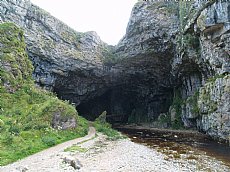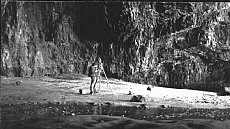Four Caves at Geodha Smoo, Sutherland
01 September 2019
- News Type:
- Site of the Month

The Geodha Smoo inlet near Durness, Sutherland, is home to a series of coastal caves. Four of these have been subject to limited excavation, which has provided valuable information of multiperiod occupation from possibly the Mesolithic to Norse periods. The most famous cave, Smoo Cave, has had the most attention but another three (named by the excavators as Glassknapper’s Cave, Antler Cave and Wetweather Cave) were investigated afterwards by GUARD in 1995 as part of a rescue excavation of coastal midden deposits.
The excavations revealed a complex story, with sometimes finds of very different dates in the same layers. Early finds reported from Smoo Cave described artefacts reminiscent of Oban Mesolithic objects although, unfortunately, these were kept by the finders. While the excavators felt that Smoo Cave might also have early deposits, the clearest evidence was from Wetweather Cave, which had sherds of Neolithic impressed ware pottery. An Iron Age midden in Smoo Cave and Iron Age pottery from Glassknapper’s cave showed occupation in later prehistoric times.
Of special significance from the sites was evidence of Norse activity: a copper alloy pin (reminiscent of examples from Freswick, Caithness) was recovered and a series of C-14 dates from Smoo Cave and Glassknapper’s Cave have provided dating between 8th – 12th centuries. Associated deposits produced valuable evidence of the use of marine and other resources in this period, including fish bones, marine shells and mammal and bird bones. The dating of the caves to the Viking period, when we have no settlements and only pagan graves in this region of Scotland (such as at nearby Balnakeil) is significant, and suggests the likelihood of possible Norse occupation sites nearby which have, so far, remained elusive with the exception of Borralie.

Full time occupation in any of the caves themselves appeared unlikely, although grain processing evidence of oat and hulled barley makes it impossible to rule out entirely. The majority of the evidence suggested that if there was occupation, it was likely to have only been on a temporary basis. The caves today (with the exception of Wetweather Cave) are relatively shallow and exposed, and the depth of the deposits which have accumulated indicate that the past floor surface would have been even lower. Storm incursions at the very least would have thus been unavoidable and some modification to the caves would have been necessary to make them inhabitable. However, no convincing evidence of this was discovered. Additionally, the artefact assemblage recovered does not reflect full time settlement either; very little pottery was present and there was a lack of other domestic artefacts which would be expected if a settlement had been present. Bone combs, for example, have been found to be fairly ubiquitous at Norse settlement sites, but none were found in the caves.
The environmental and artefactual evidence, and the marine context of the caves, indicated that the caves were used as seasonal bases for a limited range of specialised crafts and resource exploitation focused on the sea. Particularly significant among the environmental evidence was the presence of Nucella lapillus, a non-edible type of whelk used for the extraction of purple dye. The majority of these shells were were from the midden deposit also containing the probable Norse pin in Wetweather Cave, and it represents the first recorded site in Scotland with evidence for this industry. There was also evidence for the production of bone and antler tools, and several example of these worked bone tools, well preserved due to the favourable conditions produced by the shell middens. The function of these tools could not be definitively assigned but it has been suggested that at least some may relate to the maintenance of boats.
Rather more conclusively, iron nails of the type known to have been used for the construction of Viking and later vessels were recovered from both Smoo and Glassknapper’s Cave. The discovery of iron slag may indicate that these were being produced on site as well, but the clench nails themselves had clearly already been used; the remains of attached clench plates and the clench nails having two heads showed that they must have previously been attached to a boat timber that had decayed away or been burnt. If the nails had been removed from the timbers, at least one of the heads would have ben damaged, and if they were new and had not been used, they would only have had one head. The presence of these two headed clench nails therefore pointed to some form of boat repairs been undertaken in the caves.
Since Geodha Smoo forms a natural harbour, it is unsurprising that it was utilised by the Vikings, attractive as a sheltered location for the repair of their boats. The question posed by this is whether the use of this site by the Norse was as part of a larger settlement pattern within the north west of Scotland, or if the evidence in the caves resulted from the use of them as temporary stopovers by Norse mariners on journeys to or from Scandinavia and Northern and Western Isles. Only further work at the sites, of identification of new sites in the region, will answer this question.
For a programme of relatively limited excavation, the fours caves at Geodha Smoo have produced significant amounts of information. In light of the general absence of excavation work in the north-western corner of mainland Scotland, their contribution is all the more valuable. Coastal caves are often at risk of erosion, and for this reason also it is of the up most importance that any archaeology contained within them is rescued before it is lost. Shell middens are features often associated with cave sites, and are known for promoting good preservation conditions. As organic artefacts are usually lost on other sites, cave sites containing shell middens thus have the potential to preserve them and produce valuable information, as demonstrated by the caves investigated at Geodha Smoo.
Further Information
Smoo Cave (MHG11597)
Glassknapper’s Cave (MHG29334)
Antler Cave (MHG29332)
Wetweather Cave (MHG29333)
Submitted by Grace Woolmer
Site of the Month Archive
- 10/04/2021 Easter Raitts township
- 02/03/2021 Lower Slackbuie, Inverness (ASDA) Neolithic site
- 01/02/2021 Balnuaran of Clava cairns
- 04/01/2021 Wilkhouse Inn
- 02/12/2020 Spinningdale Cotton Mill
- 02/11/2020 Skibo A Canadian Forestry Camp
- 01/10/2020 WWI Detonator Store, Dalmore near Invergordon
- 03/09/2020 Mesolithic Shell Midden at Sand, Wester Ross
- 08/08/2020 Kinbeachie Neolithic settlement
- 01/07/2020 Armadale Cist Burial and Stone & Timber Complex
